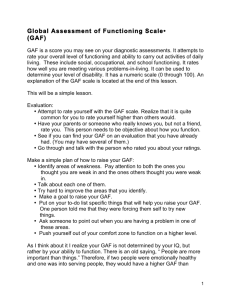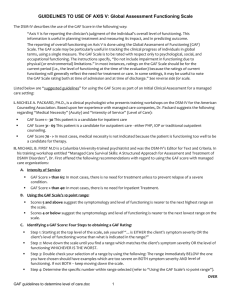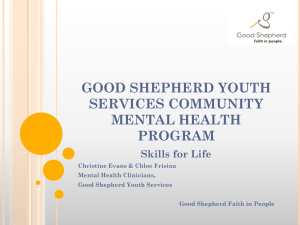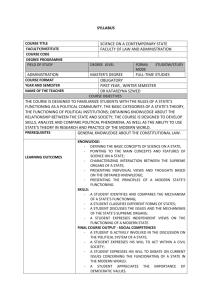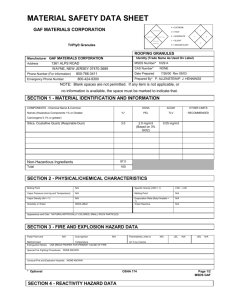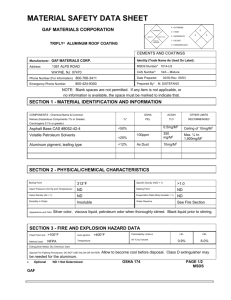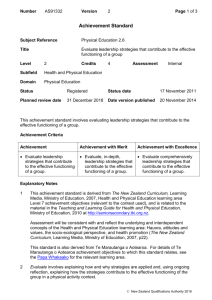GUIDELINES TO USE OF AXIS V: Global Assessment Functioning
advertisement
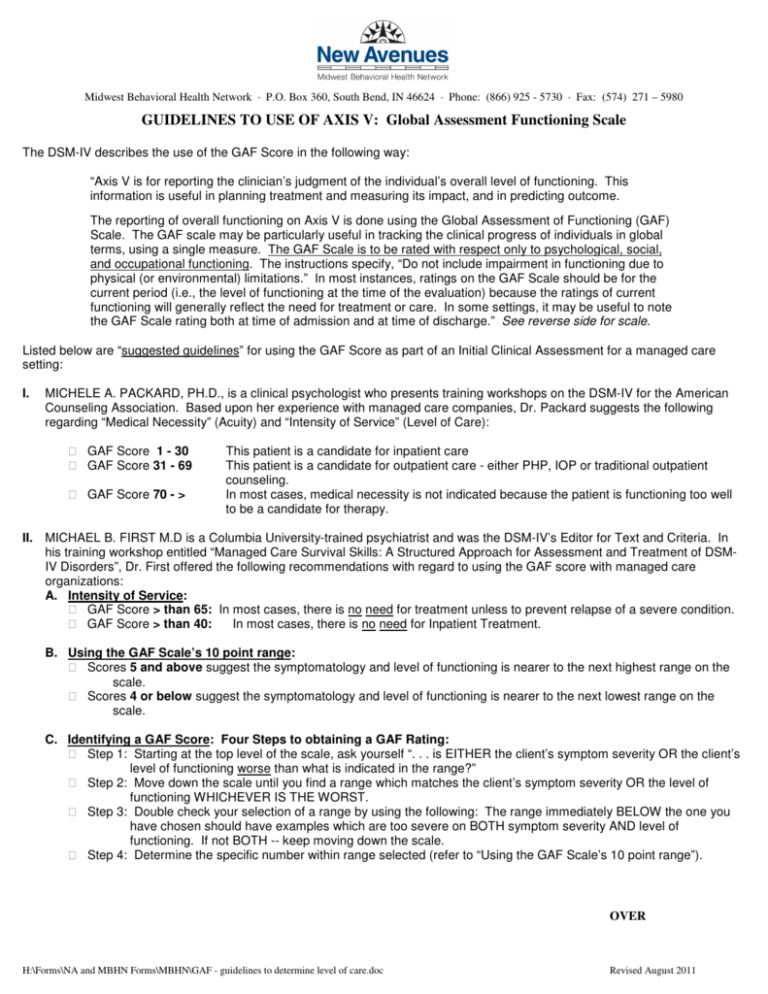
Midwest Behavioral Health Network · P.O. Box 360, South Bend, IN 46624 · Phone: (866) 925 - 5730 · Fax: (574) 271 – 5980 GUIDELINES TO USE OF AXIS V: Global Assessment Functioning Scale The DSM-IV describes the use of the GAF Score in the following way: “Axis V is for reporting the clinician’s judgment of the individual’s overall level of functioning. This information is useful in planning treatment and measuring its impact, and in predicting outcome. The reporting of overall functioning on Axis V is done using the Global Assessment of Functioning (GAF) Scale. The GAF scale may be particularly useful in tracking the clinical progress of individuals in global terms, using a single measure. The GAF Scale is to be rated with respect only to psychological, social, and occupational functioning. The instructions specify, “Do not include impairment in functioning due to physical (or environmental) limitations.” In most instances, ratings on the GAF Scale should be for the current period (i.e., the level of functioning at the time of the evaluation) because the ratings of current functioning will generally reflect the need for treatment or care. In some settings, it may be useful to note the GAF Scale rating both at time of admission and at time of discharge.” See reverse side for scale. Listed below are “suggested guidelines” for using the GAF Score as part of an Initial Clinical Assessment for a managed care setting: I. MICHELE A. PACKARD, PH.D., is a clinical psychologist who presents training workshops on the DSM-IV for the American Counseling Association. Based upon her experience with managed care companies, Dr. Packard suggests the following regarding “Medical Necessity” (Acuity) and “Intensity of Service” (Level of Care): GAF Score 1 - 30 GAF Score 31 - 69 GAF Score 70 - > This patient is a candidate for inpatient care This patient is a candidate for outpatient care - either PHP, IOP or traditional outpatient counseling. In most cases, medical necessity is not indicated because the patient is functioning too well to be a candidate for therapy. II. MICHAEL B. FIRST M.D is a Columbia University-trained psychiatrist and was the DSM-IV’s Editor for Text and Criteria. In his training workshop entitled “Managed Care Survival Skills: A Structured Approach for Assessment and Treatment of DSMIV Disorders”, Dr. First offered the following recommendations with regard to using the GAF score with managed care organizations: A. Intensity of Service: GAF Score > than 65: In most cases, there is no need for treatment unless to prevent relapse of a severe condition. GAF Score > than 40: In most cases, there is no need for Inpatient Treatment. B. Using the GAF Scale’s 10 point range: Scores 5 and above suggest the symptomatology and level of functioning is nearer to the next highest range on the scale. Scores 4 or below suggest the symptomatology and level of functioning is nearer to the next lowest range on the scale. C. Identifying a GAF Score: Four Steps to obtaining a GAF Rating: Step 1: Starting at the top level of the scale, ask yourself “. . . is EITHER the client’s symptom severity OR the client’s level of functioning worse than what is indicated in the range?” Step 2: Move down the scale until you find a range which matches the client’s symptom severity OR the level of functioning WHICHEVER IS THE WORST. Step 3: Double check your selection of a range by using the following: The range immediately BELOW the one you have chosen should have examples which are too severe on BOTH symptom severity AND level of functioning. If not BOTH -- keep moving down the scale. Step 4: Determine the specific number within range selected (refer to “Using the GAF Scale’s 10 point range”). OVER H:\Forms\NA and MBHN Forms\MBHN\GAF - guidelines to determine level of care.doc Revised August 2011 Global Assessment of Functioning (GAF) Scale CODE 100 - 91 90 - 81 80 - 71 70 - 61 60 - 51 50 - 41 40 - 31 30 - 21 20 - 11 10 - 01 NOTE Superior functioning in a wide range of activities, life’s problems never seem to get out of hand, is sought out by others because of his or her many positive qualities. No symptoms. Absent or minimal symptoms, good functioning in all areas, interested and involved in a wide range of activities, socially effective, generally satisfied with life, no more than everyday problems or concerns. If symptoms are present they are transient and expectable reactions to psychosocial stressors; no more than slight impairment in social, occupational, or school functioning. Some mild symptoms OR some difficulty in social, occupational, or school functioning, but generally functioning pretty well, has some meaningful interpersonal relationships. Moderate symptoms OR moderate difficulty in social, occupational, or school functioning in social, occupational, or school functioning. Serious symptoms OR any serious impairment in social, occupational, or school functioning. Some impairment in reality testing or communication OR major impairment in several areas, such as work or school, family relations, judgment, thinking, or mood. Behavior is considerably influenced by delusions or hallucinations OR serious impairment in communication or judgment OR inability to function in almost all areas. Some danger of hurting self or others OR occasionally fails to maintain minimal person hygiene OR gross impairment in communication. Persistent danger of severely hurting self or others OR persistent inability to maintain minimal personal hygiene OR serious suicidal act with clear expectation of death. H:\Forms\NA and MBHN Forms\MBHN\GAF - guidelines to determine level of care.doc Revised August 2011

